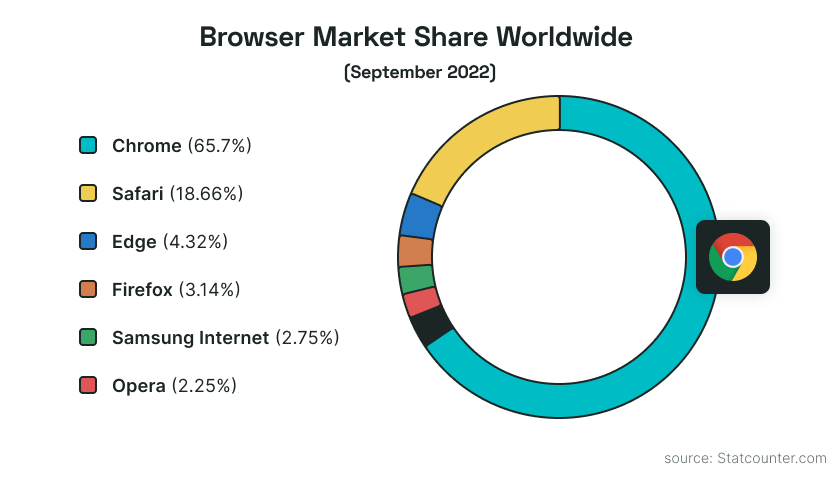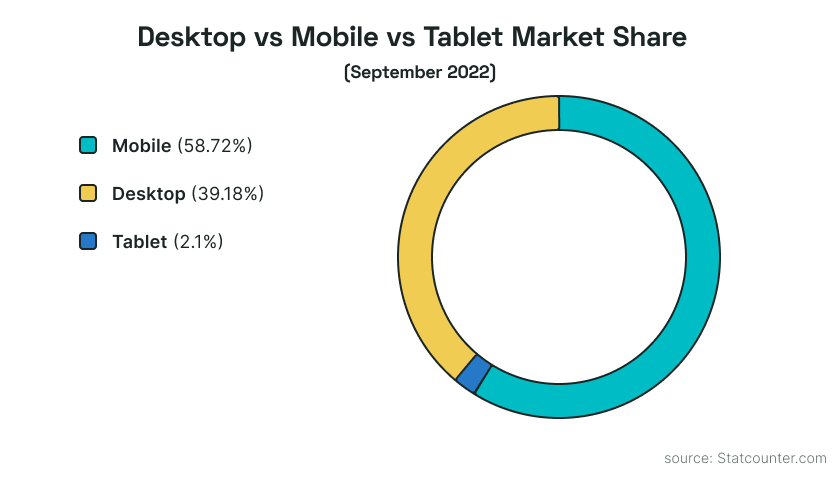Security is one word that is at the tip of everyone’s tongue when it comes to ensuring that web browsers are up to date. In August 2022, after zero day vulnerability CVE-2022-2852 was identified as a critical risk, Google issued a new set of Chrome security updates and tech-industry folks carried on with business as usual.
In general, security vulnerabilities of all types are an all-too-common game of Whac-A-Mole. Once a security flaw is discovered and patched, another pops up to take its place. However, browsers that are not updated on a regular basis for Selenium driver implementations can also create problems for website monitoring platforms offered by Uptrends and other monitoring firms.
Chrome is the most widely used browser in the world right now with just over a 65% market share. The latest Chrome update, Chrome 108, is scheduled for full release on November 29, 2022. But even before that occurs, Uptrends’ 230 checkpoint locations are in the process of updating or are already using the newest version of Chrome to monitor your website.
 That means Web Application Monitoring and Full Page Check performance monitors are already in sync to provide your users with stable, reliable service. But not all web monitoring service providers are as diligent, leaving and important question — is your website monitoring service up to date?
That means Web Application Monitoring and Full Page Check performance monitors are already in sync to provide your users with stable, reliable service. But not all web monitoring service providers are as diligent, leaving and important question — is your website monitoring service up to date?
Uptrends understands how important it is to have current browsers for your testing. We waste no time updating our checkpoints right away. By week two of a new browser release, we have every Chrome browser updated. Any problems with the latest release are identified and fixed right away.
However, other website monitoring companies aren’t as diligent with their browser updates, thereby compromising monitoring data quality — and functionality in some cases. Here’s a look at how Uptrends manages the Chrome update process.
Chrome’s version release process
Google releases an updated version of Chrome every six weeks with small patches to the version happening frequently. Updates include security and bug fixes, UI (user interface) enhancements, and less obvious things such as changes to the browser’s developer tools. Each rollout is designed to happen over a couple of weeks.

The major release every six weeks is called the stable release. Prior to the stable release, Google has three other releases or phases: canary, development, and beta.
Canary testing is the experimental phase or sandbox version of the browser where new ideas and concepts are developed and tested. Canary testing can be highly useful for system administrators who are somewhat reluctant to allow auto updates of Chrome browsers due to the potential for buggy code or other problems which will affect end user experience. Canary deployment to a small subset of end users gives developers about 3 to 4 weeks of lead time in the event that code changes cause problems with monitoring software and thereby mitigating problems for the larger group of all users.
Development is where new features get polished and tested and Beta gives users a brief period of time to test the newest version before Google finalizes the version for general release.
Google releases the new stable version in stages starting with only five percent of its Chrome users. If no problems surface, Google ramps up the updates to 15 percent of users followed by 50 percent and finally 100 percent. Therefore, you have a spike in adoption rates in the following month after release.
Updates peak in the second month, and by month four, only about two percent of users remain on the previous version.
How Uptrends keeps its monitors in sync with current browsers
When monitoring your website for speed or function —transactions for example — you need to use the same browsers that your users do. So, what browsers do your visitors use? Guessing which browsers your customers use is generally not a good idea but if you want to be certain what they’re using for with Real User Monitoring (RUM), by device for example, the following graphic makes it crystal clear. Data from StatCounter culled from August 2021 to August 2022 clearly shows Chrome topping out at around 60% for mobile and 40% for desktop with tablets flatlining most of the year at around 5%.

Uptrends puts in major efforts to run updates and keep browsers as current as possible. Our competitors can’t always be counted on to do likewise as you can see by data we compiled a few years ago.
We pay close attention to selenium driver updates to ensure with a high degree of accuracy that incompatible versions will not cause performance conflicts with Uptrends monitoring products.
One way we do this is we test and then test again well before stable versions of Chrome are released. By default, we do automated Chrome updates. But starting with a Beta version of upcoming releases, we deploy new versions of updated software via auto update to all of our 230 checkpoint servers followed by rigorous A/B testing with old and new versions for all browser monitors. This is done 10 times per monitor at which point we compare results to ensure that nothing breaks. If we encounter compatibility issues, we stop the auto update function and run deep dives to see what’s causing the problem.
In an effort to get an accurate picture of the broader user experience, Uptrends provides you with the option to test browsers other than Chrome and several popular mobile devices using our free Website Speed Test.
In brief tests using the tool, we found results as different as 2.7 seconds between browsers when testing sites such as Amazon, Google, Apple, and Samsung. As browsers evolve, so does their performance. If your website monitoring service uses older browsers to tests your website, your test results probably don’t match your users’ experiences.
If your website monitoring company doesn’t use the current browser version, your site may be malfunctioning without you knowing it, and that can be bad for business, especially for ecommerce sites.
Conclusion
As browsers evolve, so does their performance. If your website monitoring service uses older browsers to test your website, your test results will likely be out of sync with your users’ experiences. With each release, there is a chance of incongruence between your non-current browser and your monitoring tool offerings that could affect your site functionality and your business reputation without you knowing it.
Uptrends is adamant and rigorous about its policies of offering you browser-based website monitoring with the most current version of Chrome available. The end result better data quality and more accurate measurements of your page’s performance and transactions. Experience the Uptrends difference. Sign up for a free 30-day trial today.




